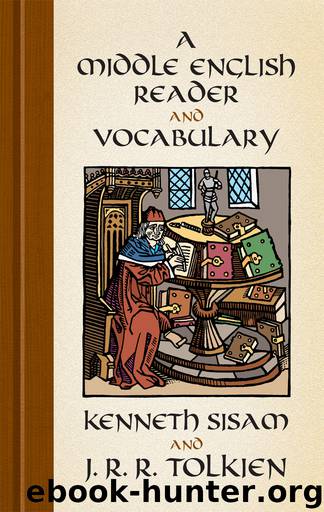A Middle English Reader and Vocabulary by Kenneth Sisam & J.R.R. Tolkien

Author:Kenneth Sisam & J.R.R. Tolkien
Language: eng
Format: epub
Publisher: Dover Publications, Inc.
Published: 2013-11-15T05:00:00+00:00
and although tangible evidence of French influence on the flexional system is wanting (for occasional borrowings like gowtes artetykes IX 314 are mere literary curiosities), every considerable settlement of foreign speakers, especially when they come as conquerors, must shake the traditions of the language of the conquered. A third cause of uncertainty was the interaction of English dialects in different stages of development.
The practical sense of the speakers controlled and balanced these disruptive factors. There is no better field than Middle English for a study of the processes of vigorous growth: the regularizing of exceptional and inconvenient forms; the choice of the most distinctive among a group of alternatives; the invention of new modes of expression; the discarding of what has become useless.
At the beginning of the fourteenth century the inflexional endings are: -e; -en; -ene (weak gen. pl.); -er (comparative); -es; -est; with -eþ, -ede (-de, -te), -ed (-d, -t), -ynge (-inde, -ende, -ande), which are verbal only.
NOTE.—(a) Sometimes one of these inflexions may be substituted for another: e.g. when -es replaces -e as the Northern ending of the 1st sg. pres. ind. Such analogical substitutions must be distinguished from phonetic developments.
(b) In disyllabic inflexions like -ede, -ynge (-ande), final -e is lost early in the North. In polysyllables it is dropped everywhere during the century.
(c) The indistinct sound of flexional -e- covered by a consonant is shown by spellings with -i-, -y- : woundis X 51; madist XI b 214; blyndiþ XI b 7; fulfillid XVI 6; etin XIV b 76; brokynne XVI 195. And, especially in West Midland texts, -us, -un (-on) appear for -es, -en : mannus XI b 234; foundun XI a 47; laghton VII 119. Complete syncope sometimes occurs: days I 198, &c.
Otherwise all the inflexions except -e, -en, are fairly stable throughout the century.
-en: In the North -en is found chiefly in the strong pp., where it is stable. In the South (except in the strong pp.) it is better preserved, occurring rarely in the dat. sg. of adjectives, e. g. onen III 4, dat. pl. of nouns, e. g. diaknen III 5, and in the infinitive; more commonly in the weak pl. of nouns, where it is stable, and in the pa. t. pl., where it alternates with -e. In the Midlands -en, alternating with -e, is also the characteristic ending of the pres. ind. pl. As a rule (where the reduced ending -e is found side by side with -en) -e is used before words beginning with a consonant, and -en before words beginning with a vowel or h, to avoid hiatus. But that the preservation of -en does not depend purely on phonetic considerations is proved by its regular retention in the Northern strong pp., and its regular reduction to -e in the corresponding Southern form.
-e: Wherever -en was reduced, it reinforced final -e, which so became the meeting point of all the inflexions that were to disappear before Elizabethan times.
-e was the ending of several verbal forms; of the weak adjective and the adjective pl.
Download
This site does not store any files on its server. We only index and link to content provided by other sites. Please contact the content providers to delete copyright contents if any and email us, we'll remove relevant links or contents immediately.
Evelina by Fanny Burney(26797)
Evelina, Or, the History of a Young Lady's Entrance into the World by Fanny Burney(26232)
Twilight of the Idols With the Antichrist and Ecce Homo by Friedrich Nietzsche(18504)
Pale Blue Dot by Carl Sagan(4913)
The Perks of Being a Wallflower by Stephen Chbosky(4575)
Dune 01 Dune by Frank Herbert(4313)
Double Down (Diary of a Wimpy Kid Book 11) by Jeff Kinney(4207)
Man and His Symbols by Carl Gustav Jung(4069)
Walking by Henry David Thoreau(3894)
Separate Beds by LaVyrle Spencer(3771)
Ficciones by Jorge Luis Borges(3573)
FOUNDATION AND EMPIRE by Isaac Asimov(3551)
The 101 Dalmatians by Dodie Smith(3454)
Mystery at School by Laura Lee Hope(3372)
Anna and the French Kiss by Stephanie Perkins(3319)
120 Days of Sodom by Marquis de Sade(3182)
Some Prefer Nettles by Tanizaki Junichiro(2842)
The Little Prince by Antoine de Saint-Exupéry(2828)
My Ántonia by Willa Cather(2812)
